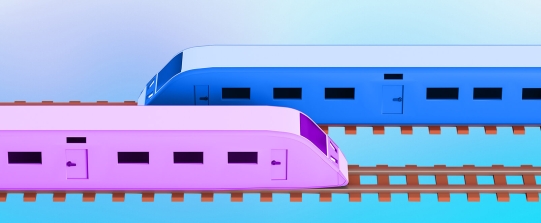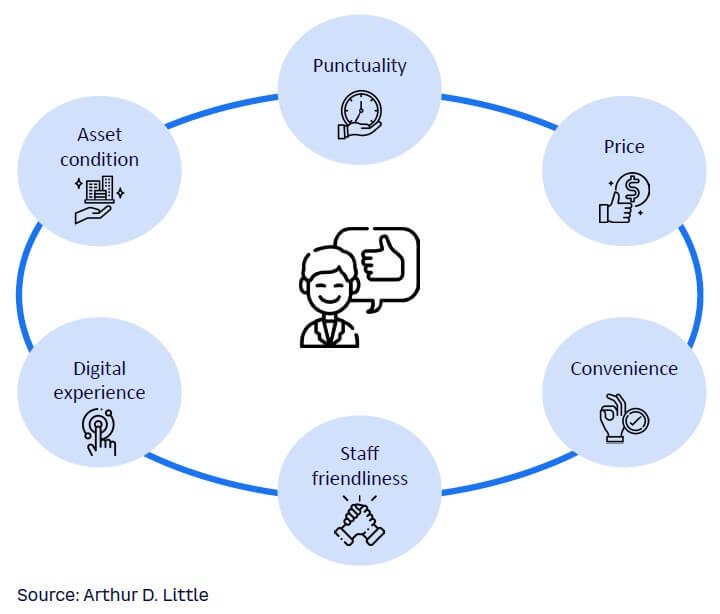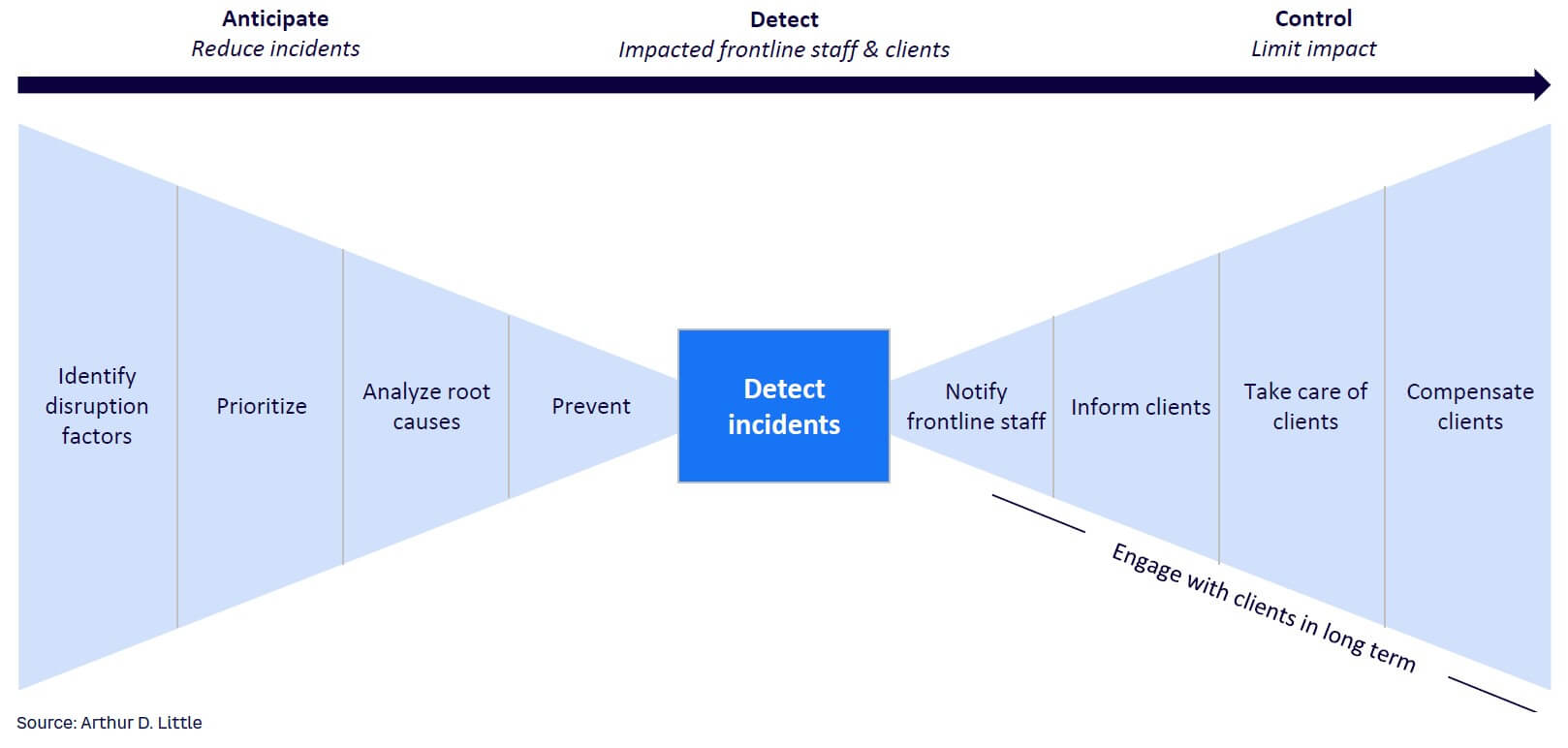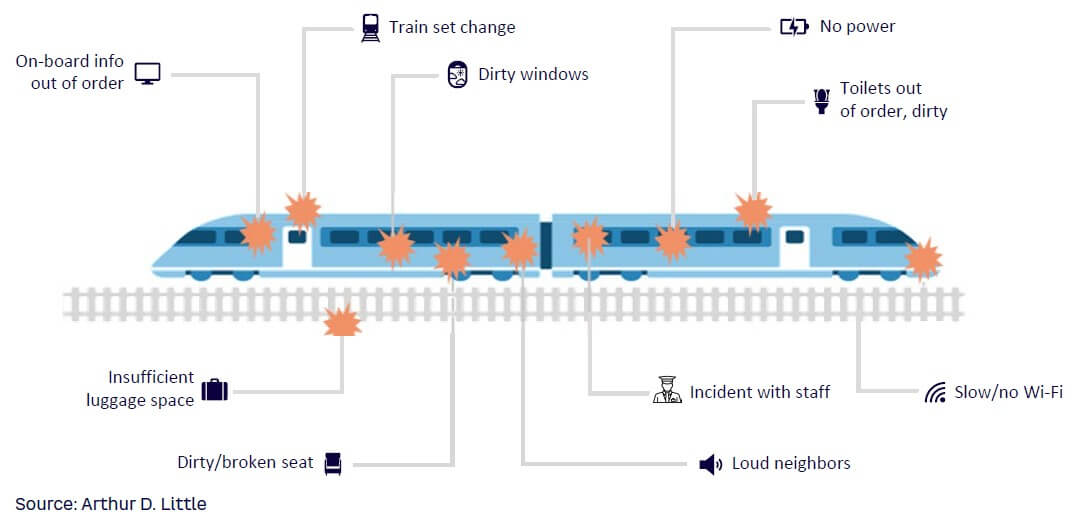
Performance around punctuality (and regularity) has not made enough progress in reaching customers’ high standards in spite of many programs. Similarly, the occurrence of other adverse events — faulty passenger information, defective seats — and the absence of prompt, satisfactory treatment of such issues generate disappointment, which may offset any positive customer experiences. In this Viewpoint, we reflect on the levers transport operators should put in place to better prevent, identify, and control operational incidents — and boost customer satisfaction.
PUNCTUALITY: THE PRIORITY OF OPERATORS
In long-distance transportation, the dominant factor in customer satisfaction relates to punctuality. Indeed, according to an Arthur D. Little (ADL) benchmark, punctuality measures up to 40% of total passenger satisfaction as customers expect to arrive (and depart) on time, especially on train systems where each minute is of the essence. Figure 1 illustrates the reasons behind delays.

Logically, transport operators have sharply focused on punctuality, monitoring it closely and deploying large improvement programs throughout their organizations; for example:
-
Network Rail (UK) introduced a new, detailed, and precise set of measures in 2019 to better understand the timeliness of its trains — from station to station, from minute to minute.
-
SNCF (France) released its “H00” plan in 2018, aiming for 90% departure punctuality, and a strong customer promise with its “G30 warranty” — giving financial compensation to clients in case train arrival is delayed by more than 30 minutes.
-
SNCB/NMBS (Belgium) set up an action plan in collaboration with Infrabel (a Belgian railway infrastructure manager) aiming at significantly reducing the number of incidents that impact punctuality. This included a specific focus on joint actions at the interfaces between both organizations and other stakeholders.
-
Deutsche Bahn (Germany) has implemented its “Strong Rail” strategy, which targets an improvement in punctuality to more than 85% with DB Bahn Long Distance. To achieve this, the company relies on an infrastructure upgrade with targeted maintenance measures, increased vehicle availability and quality, and the introduction of supporting systems, including the implementation of forecasting systems (like big data) to generate an early response to disruptions.
-
Public transport authorities add to the momentum, specifying punctuality/regularity targets to operators with associated rewards or penalties.
However, despite potential progress, overall client satisfaction on a yearly basis may remain low as there could be a disconnect between satisfaction studies on a trip basis (which might show 90% satisfied passengers) and net promoter score (NPS) level (which could be negative).
Customer excellence is a highly complex and difficult venture. Transporting a passenger from A to B generates a multitude of contact points, where varied types of incidents can occur.
As illustrated in Figure 2, traffic management remains a crucial issue for punctuality in the railway industry. We observe the same issue for flights, but the phenomenon on that side of transport results from the massive number of movements performed by planes in a dense airspace, making it more difficult to make up for any delays.

THE IMPOSSIBLE CHALLENGE TO EXCEL ACROSS EVERY TOUCHPOINT
Customer satisfaction is not an average of satisfaction across touchpoints, or the average of all trips. Indeed, the worst experience on the worst touchpoint contributes highly to the NPS. For instance, an awful experience on just one touchpoint across one single journey (see Figure 3) leaves a terrible impression and a very dissatisfied customer, however good the rest of the experience may be.

Punctuality is of the essence, but it is not the only factor. Passengers experiencing an issue with their seat (e.g., dysfunction with an armrest, table, power plug) might be as dissatisfied as passengers confronted with a very long delay (i.e., several hours). Even worse, if a passenger is a regular traveler (usually, half of long-distance passengers are returning customers), his or her recommendations to the service more often will come from the worst experience over the last weeks or months and how it was handled.
This represents a huge challenge for operators, as they need to excel on all touchpoints if they want to augment client retention in an increasingly competitive world:
-
Not only do their transport systems need to be punctual, they also must be clean and functional.
-
The experience needs to be well thought out and fluid, easily accessible to all kinds of customers.
-
Staff needs to be well-trained to cater to customer needs.
-
The digital experience must be faultless.
Such a level of operational and service excellence is a huge challenge in mass transportation. Dense networks generate delays; low staff-to-customer ratio does not allow for high personalization; high asset utilization comes at a price in wear and tear; and so forth. However, there’s some good news on the operators’ side:
-
First, customers understand the complexity of transport operations and often allow for some slack if they are well-informed and well cared for.
-
Second, the digital age enables operators to constantly monitor situations, inform customers and clients, and address issues.
Yet the bar remains high. Through online shopping, customers are accustomed to real-time tracking; live information; and extremely efficient, smooth, proactive, and fast problem-solving; for example:
-
Customers expect transport operators to efficiently and immediately leverage all internal and external data.
-
Consumers are used to a unique, differentiated treatment and expect the same in all their interactions, including travel.
INCIDENT MANAGEMENT EXCELLENCE FRAMEWORK
Built on experience across multiple transport operators, ADL has developed the Incident Management Excellence framework, derived from an engineering risk-analysis methodology known as the “bow tie” (see Figure 4). The framework is two-fold, emphasizing both hazard risk prevention (the left side of the bow tie) and hazard recovery (the right side). We believe transport operators should employ this balanced approach to excel in their customer experience improvement projects.

Indeed, preventing incidents will always be a core activity of transport operators, given that incidents are costly, both in direct monetary terms (e.g., asset immobilization, opportunity cost in revenue, disorganization of staff schedules, overtime) as well as via client impact (e.g., delays, discomfort, degraded image). Thus, operators strive to prevent incidents as much as possible and to reduce their occurrences.
Yet, limiting the impact of incidents is easier said than done. Three obstacles challenge transport operators and require a shift in mindset:
-
Operators are so geared toward reducing incident occurrence that it is sometimes very difficult to focus on addressing incidents when they happen. This requires a shift in thinking that begins with the realization that whatever the efforts, there will always be incidents — but the aim should be as few as possible.
-
Identifying incidents and notifying frontline agents in real time is complicated. The data exists but is often scattered across various legacy systems. It takes time, strong will, and money to have all systems communicate in real time and push notifications so that staff can be informed. For example, data about vehicle maintenance and possible dysfunctions is often privy only to maintenance staff and rarely pushed to frontline staff. Train managers thus often discover dysfunctions as they board their trains. Airlines, on the other hand, are leading in this area by pushing as much information as possible to crews so that they are prepared to address potential issues.
-
Once it is accepted that some incidents will occur, it takes a third mindset shift to understand that contingency plans prepared in advance bring value to the operator. There are two obstacles to this realization: (1) preparing contingency plans takes time, which operators would rather allocate to reducing incident occurrence; and (2) staff culturally tends to prefer reinventing emergency plans for each occurrence. Contingency plans make daily operations much more efficient but can be seen as much less fun for staff that often prefer a tailored approach.
BREAKING DOWN THE FRAMEWORK
Phase 1: Anticipate — Reduce incidents via predictive analytics & root-cause analysis
Identify, prioritize & analyze incidents
Before diving into incidents handling, operators must have a firm understanding of identifying and prioritizing priority incidents. Traditionally, when considering incidents affecting the customer journey, transport operators monitor delays above all else. They are right to do so, as punctuality is the dominant driver in customer satisfaction in transport. A detailed root-cause analysis is necessary to identify clearly what is behind the problem, from operational mistakes to structural deficit, for instance, in network conditions.
However, there is also a multitude of non-punctuality incidents that occur and impact customer satisfaction (see Figure 5). Operators should closely identify and monitor such events:
-
At the individual level, a broken seat or tablet will impact client satisfaction as badly as an extreme delay. Fortunately, these are localized and will not impact a whole train, but they cannot be neglected nonetheless.
-
Intermediately, broken toilets or air-conditioning will not affect all passengers but will impact very negatively the clients seated in the carriage concerned.
-
Heated discussion with staff or a fellow passenger is also a destructor element.

Once all these issues are laid out, the question arises of how to prioritize non-punctuality incidents. We believe that the approach needs to be strongly customer-centric and data-centric to deliver results:
-
Voice of the Customer (VoC) is a powerful tool to identify and monitor key incidents, their volume, and the tone used by the customer. When properly formatted, this data stream works as both a C-level monitoring tool and as a way to engage frontline staff, as well as an early warning system for project managers who handle client experience.
-
Voice of the Agent (VoA) should complement clients as a mirror for early detection of hiccups. Often, staff irritants are also client irritants, and frontline staff generally will be more precise in their incident descriptions. Data streams with frontline staff verbatims typically exist in transport operator systems, but they need to be assembled, analyzed, and monitored, which is more rarely the case.
Prevent incidents
From a customer perspective, the optimal experience is a smooth faultless one. Operators thus strive to reduce the occurrence of incidents by acting on four key horizons:
-
Robust design reduces the occurrence of incidents; infrastructure, train sets, and operations can be designed to minimize incidents. Typically, robust operations design will allocate buffers in the schedule to ensure vehicles can realistically arrive on time.
-
Smart maintenance will reduce the number of incidents with infrastructure or vehicles. Thanks to sensors, advanced signals can be detected and addressed before faults actually happen. Even without sensors, the smart use of data can help review kilometer-based maintenance schemes to introduce variability on other relevant factors. For example, the emptying of toilets can be programmed based on type of customer, on hour of day or season, and on trip length — not just based on number of kilometers since last operation.
-
Robust operations are key in preventing incidents. Staff members need to be properly trained and engaged so that they have a high sensitivity to all incidents affecting customer experience.
-
Quick repairs limit incidents, as they shorten downtime and prevent further cancellations/delays, or, on a smaller scale, ensure fewer customers are affected by a broken seat, for example.
Phase 2: Detection — Ensure live detection through effective information/data sharing
Reactivity is one of the key success factors of incident recovery from a customer perspective. Different technological drivers ease live detection:
-
4G/5G/ Wi-Fi connectivity.
-
Development of Internet of Things (IoT) in transportation infrastructure and fleet.
-
Live access to third-party data through open data protocols.
-
Equipping staff with smartphones.
-
Artificial intelligence/machine learning.
Once collected, data should be integrated into the platform to transform insights into tangible actions and information.
Live, automated incident identification is the cornerstone on which to build any serious customer satisfaction improvement program. The Incident Management Excellence framework helps ensure the success of that all-too-important step:
-
Once impacting incidents are identified and monitored, they should be assembled in relevant IT systems in real time.
-
This is no small feat, as incidents are widespread and varied: delays (well-monitored), passenger loads and typology (usually followed by commercial department in a different IT system), vehicle equipment status (controlled by maintenance department in yet another IT system), staffing, and so forth. Sometimes, even getting vehicle status is difficult. In the absence of sensors, getting a grasp of the actual state of all client equipment requires detailed inspections of seats, plugs, armrests, bins, and so on — or an efficient crowdsourcing approach for frontline staff and/or customer.
But without knowing all the incidents affecting customers in real time, there is no way of informing customers, let alone taking care of them when incidents surface. And although this task may seem impossible, customers often believe that the data is “somewhere” and it is up to the operator to assemble it to deliver top-notch service.
In addition, or alternatively, to live, automated detection is, of course, the traditional way of detecting incidents via employees. As a third option, it might make sense to motivate customers to support detection and actively raise their voices. This can be done via an app or text message. Examples have shown that this is critical in two ways: (1) the customer is actively asked to search for problems and mistakes, and (2) due to the high number of passengers, the quantity of feedback is enormous and the capacity needed to follow up (the mostly tiny issues) and respond is very high.
Phase 3: Control — Limit impact by notifying staff & clients
When it comes to customers, five levers are key in reducing the impact of incidents on customers when they occur:
-
Notify frontline staff.
-
Inform clients.
-
Take care of clients, if appropriate.
-
Compensate clients, if appropriate.
-
Engage with clients in the long term.
Notify frontline staff
A well-informed frontline staff is key. Fostering such an environment allows agents to better perform their tasks, prepares them in avoiding unpleasant surprises, and puts them in a role where they are ready to deliver optimal service to customers. Informed staff will always deliver better service to clients, especially if an incident arises.
We have identified three strong blocks that hamper efficiency:
-
Information is not always readily accessible.
-
Tools that push information to frontline staff are not always developed.
-
It’s not always thought relevant to inform staff about incidents.
Once incidents are identified somewhere in the transport operator system, they need to be pushed out to frontline staff by some type of channel. This requires data flows, often costly, and reception tools on the staff side. Though staff is increasingly equipped with handheld terminals, the applications in them are not always functional to push information about incidents, and development can be costly. It is also key to distribute information to relevant staff at the right moment and ensure they can access it easily. For example, when it comes to the occurrence of a large incident, the entire frontline staff should be informed at once, not just the manager.
Inform clients
Operators must also notify customers. In the case of various incidents, the perceived quality of information has a tremendous effect on client satisfaction. Among customers affected by an incident, those who assess information quality as “average” have a satisfaction rate that is several orders of magnitude greater than customers totally unhappy with information delivered. This is excellent news for transport operators. An operator can transform an incident into a positive experience if managed well.
The policy of informing clients of incidents applies to delays naturally, but also to many other kinds of incidents. For example, a client informed in advance about service restrictions (e.g., limited catering) will often get around the problem ahead of departure (e.g., by buying food in advance) or will at least adjust expectations.
Take care of clients
Taking care of customers encompasses two steps. The first is to inform customers of alternatives available (e.g., next departure, closest functioning equipment available). The second is to personally intervene and alleviate the consequences of the incident.
Compensate clients
The transport operator can decide to acknowledge the hardship endured by the customer and provide a compensation. The compensation can be regulatory (EU 261) or voluntary (train operators). It can be allocated with cash, ticket vouchers, or through customer enhancements, such as an upgrade, a drink/meal voucher, and so forth.
Ideally, client compensation should be fine-tuned and adapted to each client’s history. For instance, it might be more cost-effective not to compensate a client encountering a delay of 20 minutes for the first time. But the same client impacted by a 20-minute delay for the fifth time in a row in a single month may need compensation.
Airlines (e.g., Delta) are leading the way in fine-tuning compensation to better reflect clients’ unique experiences. It requires two elements:
-
Superior customer relationship management system, enriched by operational data in order to build a full overview of client interactions with the operator as well as any hiccups encountered along the way.
-
Because it’s virtually impossible to specify all cases in a long-term relationship between a customer and an operator, frontline employee empowerment is the second key to efficient compensation. Frontline staff will need to have access to the history of client incidents and use their best judgement to assess the appropriate compensation for the incident at hand. Broad guidance can help them make these decisions, but employees need to be given enough flexibility to adapt to each individual situation.
Engage with clients
Transport operators’ clients typically encounter incidents at some point in time. Regular clients are even accustomed to incidents. It is therefore fundamental to engage with clients when incidents occur. We have developed a three-layer approach in client engagement:
-
Short but frequent feedback requests should be sent to most clients after each trip, by any channel but preferably the operator’s digital channels. By short, we actually mean short. If an operator is to engage regularly with customers and expect them to answer, the only acceptable approach is to cut down on the questions. Ideally, two questions are addressed to the customer: one closed question to rate satisfaction and one open question to collect spontaneous feedback. The satisfaction rate helps guide daily customer satisfaction needs with your operational staff, while the verbatims collected enable monitoring of strong and weak signals on all matters.
-
Detailed feedback can be asked from clients as well but should occur on an infrequent and voluntary basis in order to assess the drivers of client satisfaction in depth and adapt your strategy toward preventing incidents.
-
Finally, customers should be treated uniquely and engaged individually. This means logging the incidents that affect regular travelers along the months, informing frontline staff about previous incidents, and individualizing treatment so that a particular customer’s incident frequency can be addressed. A delay of 10 minutes may in some occurrences be acceptable once, but it becomes highly irritating the third time in a row. The best way to accommodate for such individualization of engagement is to give frontline staff a degree of autonomy in deciding compensation.
Conclusion
PRIORITY ACTIONS FOR TRANSPORT CXOs
Incident management excellence should be incorporated into the CxO agenda of transport operators. Applying the framework is crucial for competitiveness and differentiation in a time when both competitive intensity between operators and between modes is getting more tense. From a system perspective, better predictability and control of incidents will be a key driver of the modal transition and increased adoption of shared modes.
A few concrete actions to take:
-
Conduct a health check — analyze level of customer experience already delivered in nominal and non-nominal situations; review possible pitfalls and identify key areas for improvement.
-
Develop a performance plan — identify key operational/marketing and commercial actions to address issues; design a plan with clear targets and responsibilities across organizations.
-
Run a continuous improvement program — develop a dashboard to allow CxOs to follow real-time situations, track progress, and initiate additional actions if required.






